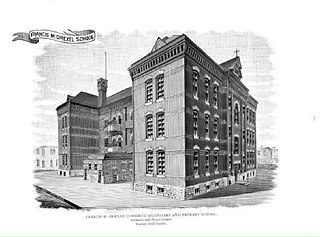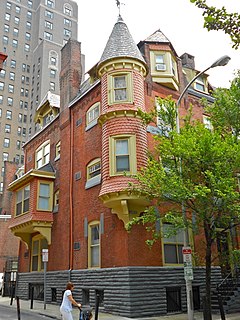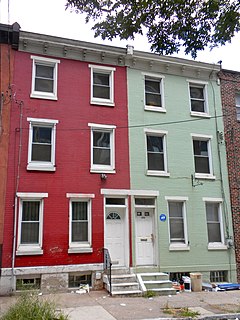
West Philadelphia, nicknamed West Philly, is a section of Philadelphia, Pennsylvania. Though there is no official definition of its boundaries, it is generally considered to reach from the western shore of the Schuylkill River, to City Avenue to the northwest, Cobbs Creek to the southwest, and the SEPTA Media/Elwyn Line to the south. An alternate definition includes all city land west of the Schuylkill; this would also include Southwest Philadelphia and its neighborhoods. The eastern side of West Philadelphia is also known as University City.

Overbrook Farms is a neighborhood on the western edge of the West Philadelphia section of Philadelphia, Pennsylvania, United States. It is roughly bounded by City Avenue, 58th Street, Woodbine Avenue, and 66th Street at Morris Park. The neighborhood is bisected by Lancaster Avenue and the original Pennsylvania Railroad "main line". Today the rail line is used by both Amtrak passenger service and SEPTA's commuter Paoli/Thorndale Line.

The Woodlands is a National Historic Landmark District on the west bank of the Schuylkill River in Philadelphia. It includes a Federal-style mansion, a matching carriage house and stable, and a garden landscape that in 1840 was transformed into a Victorian rural cemetery with an arboretum of over 1,000 trees. More than 30,000 people are buried at the cemetery.

Haddington is a neighborhood in the West Philadelphia section of Philadelphia, Pennsylvania. Its borders are defined as Haverford Avenue/Girard Avenue to the north, 52nd Street to the east, Market Street to the south, and 67th Street to the most western edge of the neighborhood. It is a largely African American community of mostly two-story rowhouses with a large proportion of elderly residents and a high home-ownership rate. Near the intersection of Vine Street and 56th Street, new construction and community facilities were built in the 1970s thanks to the Haddington Leadership Organization.

Samuel Sloan was a Philadelphia-based architect and best-selling author of architecture books in the mid-19th century. He specialized in Italianate villas and country houses, churches, and institutional buildings. His most famous building—the octagonal mansion "Longwood" in Natchez, Mississippi—is unfinished; construction was abandoned during the American Civil War.

G. W. & W. D. Hewitt was a prominent architectural firm in the eastern United States at the turn of the twentieth century. It was founded in Philadelphia in 1878, by brothers George Wattson Hewitt (1841–1916) and William Dempster Hewitt (1847–1924), both members of the American Institute of Architects. The firm specialized in churches, hotels and palatial residences, especially crenelated mansions such as Maybrook (1881), Druim Moir (1885–86) and Boldt Castle (1900–04). The last was built for George C. Boldt, owner of Philadelphia's Bellevue-Stratford Hotel (1902–04), G.W. & W.D. Hewitt's most well-known building.

The Alta Vista Terrace District is a historic district in the Lake View community of Chicago, Illinois. The district was built in 1904 in imitation of the rowhouse style of London.

The Centennial National Bank is a historic building in Philadelphia, Pennsylvania. Designed by noted Philadelphia architect Frank Furness and significant in his artistic development, it was built in 1876 as the headquarters of the eponymous bank that would be the fiscal agent of the Centennial Exposition. The building housed a branch of the First Pennsylvania Bank from 1956 until Drexel University purchased it c. 1976. Drexel renovated it between 2000-2002 and now uses it as an alumni center. The Centennial National Bank, described as "one of the best pieces of architecture in West Philadelphia," was placed on the National Register of Historic Places in 1971.

The Francis M. Drexel School was a historic school in Philadelphia, Pennsylvania, United States. Located along Sixteenth Street, the school was designed by Joseph Anschutz and built under the direction of Charles O'Neill, Jr. The three-story brick building was built in a regular rectangular plan in the Victorian style of architecture, with three chimneys dominating its facade.

Willis Gaylord Hale was a late-19th century architect who worked primarily in Philadelphia, Pennsylvania. His flamboyant, highly-ornate style was popular in the 1880s and 1890s, but quickly fell out of fashion at the dawn of the 20th century.

Knickerbocker Historic District is a national historic district located at Altoona, Blair County, Pennsylvania. The district includes 153 contributing rowhouse buildings in a residential area of Altoona. The buildings were primarily built between 1903 and 1930, as affordable worker's housing and reflect a number of popular architectural styles including Colonial Revival and Classical Revival. The buildings feature decorative parapets, bay windows, porch posts, pediments, and a variety of ornamentation. The district is visually dominated by the former Knikerbocker Hotel.

West Norristown Historic District is a national historic district located in Norristown, Montgomery County, Pennsylvania. It encompasses approximately 1,700 buildings in a primarily residential neighborhood in the West End of Norristown. The housing predominantly consists of rowhouses with a large number of semi-detached houses. The area was developed between 1885 and 1925 and the houses are in a variety of popular late-19th and early-20th-century architectural styles.

William Strickland Row was a set of seven historic rowhouses, four of which survive. The row was designated a national historic district which is located in the Washington Square West neighborhood of Philadelphia, Pennsylvania. The brick houses were built about 1815, and measure between 16 feet, 6 inches, and 20 feet wide and 35 feet deep. They are each designed in the typical Philadelphia rowhouse plan of the period with front building, piazza, and back building. The exhibit Greek Revival style design details.

Hockley Row – also known as Evans Row or Victoria House – is a set of four architecturally significant rowhouses, located in the Rittenhouse Square West neighborhood of Philadelphia, Pennsylvania.

Walnut–Chancellor Historic District is a national historic district located in the Rittenhouse Square West neighborhood of Philadelphia, Pennsylvania. It encompasses 51 contributing buildings located one block east of Rittenhouse Square. It includes 4 1/2- to 5-story monumental residences in the Italianate style; brick rowhouses dated to the 1860s-1870s, some with mansard roofs and dormers; and 19th century carriage houses. Located in the district is the Thomas Hockley House (1875), designed by architect Frank Furness (1839-1912).

Girard Avenue Historic District is a national historic district located in the Cabot neighborhood of Philadelphia, Pennsylvania. It encompasses 137 contributing buildings. They were largely built in the mid- to late-19th century and consist of residential, commercial, and industrial properties. The residential buildings include blocks of 19th century speculative rowhouses. Residential buildings include notable examples of the Greek Revival, Late Victorian, and Beaux Arts styles. Notable non-residential buildings include the Church of the Gesú (1879), designed by Edwin Forrest Durang, and Northwestern National Bank (1886).

Hollins–Roundhouse Historic District is a national historic district in Baltimore, Maryland, United States. It is a primarily residential area characterized by 19th century rowhouses. The neighborhood is historically significant due to its association with the development of rail transportation in Maryland. Additional historical significance comes from the neighborhood's association with ethnic immigration to Baltimore. During the 1840s and 1850s the area was a center of settlement for Baltimore's German and Irish communities, many of whom immigrated to the United States to work in the rail industry. Later, from the 1880s to the 1920s, the neighborhood became established as the center of Baltimore's Lithuanian immigrant community. Because of the large Lithuanian population in the area north of Hollins Street, the area became known as Little Lithuania. A few remnants of the neighborhood's Lithuanian heritage still remain, such as Lithuanian Hall located on Hollins Street.

Queen Anne Historic District is a national historic district located in Reading, Berks County, Pennsylvania. The district encompasses 2,405 contributing buildings in Reading built between about 1880 and 1925. The district consists primarily of semi-detached houses and rowhouses, with a few stone church buildings and small commercial buildings. Most of the buildings are constructed of brick and reflective of Late Victorian and early 20th-century architectural styles. The churches are St. Mary's Episcopal Church (1904) and Wesley United Methodist Church (1922). Located in the district and separately listed are the Charles S. Foos Elementary School and former Meinig Glove Factory-E. Richard Meinig Co.

Edmund Beaman Gilchrist was an American architect, best remembered for his English-Cotswold and French-Norman suburban houses.

The Gateway Village Historic District encompasses a World War I-era housing project on the east side of Bridgeport, Connecticut. Centered on Alanson Road, the project was developed in the later years of the war to provide emergency housing for workers in the city's munitions factories. It is a rared design attributed to the female-led architectural firm Mead & Schenk, and is an early example of Garden City movement design. It was listed on the National Register of Historic Places in 1990.

























